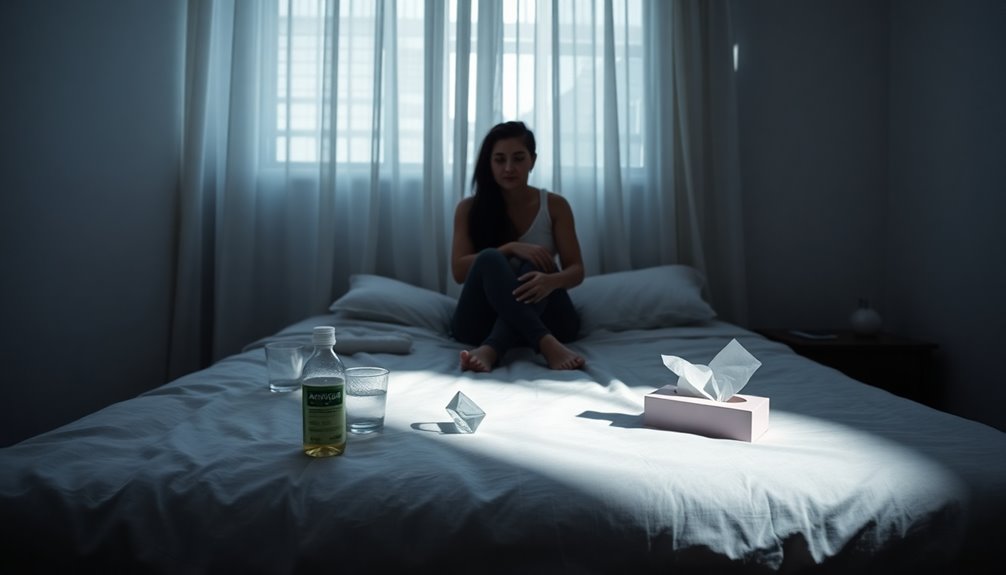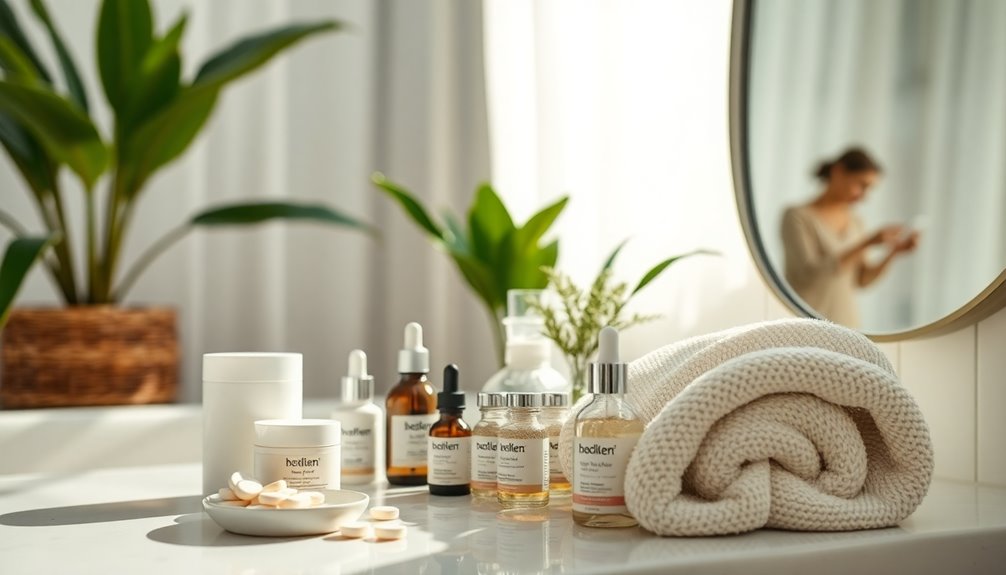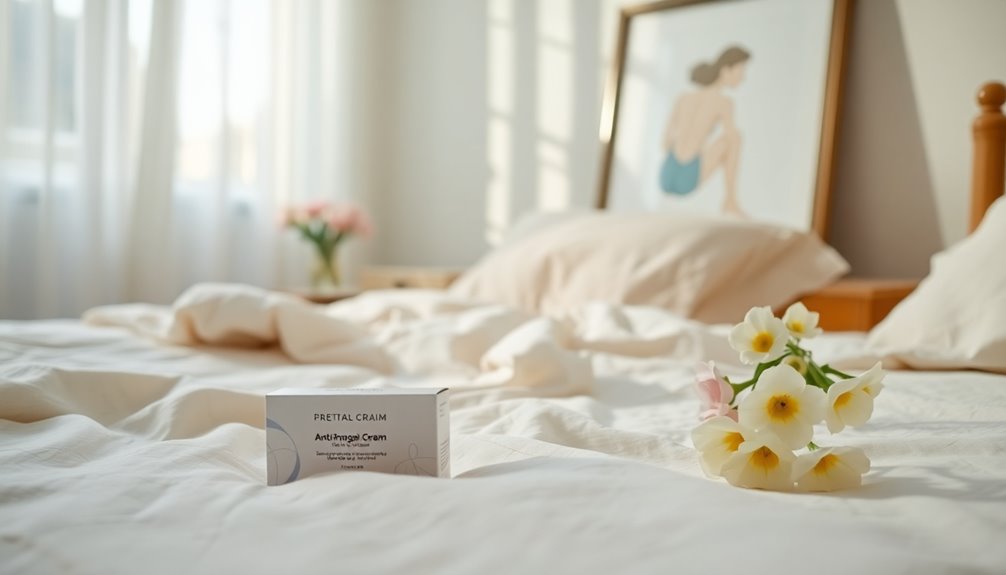You might think about having sex during a yeast infection, but it's usually not a good idea. Doing so can lead to significant discomfort and may worsen your symptoms. Pain and irritation can make intimacy challenging for both you and your partner. Medical advice generally suggests avoiding sexual activity until the infection has completely cleared up for everyone's comfort and healing. If you decide to engage in any intimacy, communicate openly with your partner and consider non-penetrative activities. There's more you can discover about managing yeast infections effectively and ensuring your comfort.
Key Takeaways
- Engaging in sexual activity during a yeast infection can increase discomfort due to irritation from moisture and friction.
- Pain during intercourse, known as dyspareunia, is common with yeast infections, affecting intimacy.
- Medical professionals typically recommend avoiding sex until symptoms have resolved for comfort and effective healing.
- Open communication with partners about discomfort is essential to make informed decisions regarding intimacy.
- Consider non-penetrative intimacy and the use of lubrication if engaging in sexual activity during a yeast infection.
Understanding Yeast Infections

While it's common to experience discomfort during a yeast infection, understanding the condition is essential for managing symptoms effectively.
A yeast infection, primarily caused by an overgrowth of the Candida fungus, often leads to symptoms like itching, burning, and unusual vaginal discharge. This white, clumpy discharge can disrupt your comfort, especially during sexual activity.
Approximately 75% of women will face at least one yeast infection in their lifetime, making it a common concern. Risk factors include antibiotic use, uncontrolled diabetes, hormonal changes, stress, and a weakened immune system.
Diagnosis usually involves a medical examination and possibly lab tests to confirm the presence of Candida species. Knowing these details can empower you to manage this condition better.
Symptoms and Discomfort

Experiencing a yeast infection can make intimacy challenging, especially when pain during intercourse becomes an issue.
You might find that the discomfort not only affects your physical experience but also impacts your emotional connection with your partner.
It's crucial to openly discuss these symptoms to guarantee both of you feel comfortable and understood.
Pain During Intercourse
Having a yeast infection can make sex particularly painful due to the irritation and inflammation of vaginal tissues.
You may experience symptoms like itching, burning, and swelling, which can intensify during penetration, leading to painful intercourse. The irritation can increase sensitivity, causing heightened pain during any form of sexual activity.
Additionally, the moisture produced during arousal might worsen itching and discharge, further contributing to discomfort.
Medical advice typically recommends avoiding sexual activity until your yeast infection symptoms have fully resolved. This not only promotes healing but also prevents the worsening of symptoms, allowing you to return to a more comfortable and enjoyable sexual experience once you're free from the infection.
Impact on Intimacy
A yeast infection can greatly impact intimacy, as the discomfort and symptoms often lead to reluctance in engaging in sexual activities.
Itching, burning, and pain during penetration can make the thought of intimacy challenging. You may find that increased moisture from arousal exacerbates these symptoms, turning what should be an enjoyable experience into a frustrating one.
Swollen labia or vulva can further complicate skin-to-skin contact, adding to the discomfort.
Open communication with your partner about these symptoms is essential; discussing your feelings and limitations guarantees mutual understanding and consent during this sensitive time.
Prioritizing your comfort and well-being can help you navigate intimacy while managing a yeast infection, paving the way for a healthier relationship.
Sexual Activity Considerations

When you're dealing with a yeast infection, pain during intercourse can considerably increase due to irritation and inflammation.
It's essential to communicate openly with your partner about your discomfort and the situation.
This way, you can both make informed decisions about engaging in sexual activity.
Pain During Intercourse
Engaging in sexual activity while dealing with a yeast infection often leads to discomfort, primarily due to inflammation and irritation of the vaginal tissues.
You might experience pain during intercourse, known as dyspareunia, which can stem from symptoms like itching and burning. Increased moisture during arousal can worsen itching and discomfort, making intimacy less enjoyable.
To promote healing and comfort, consider the following:
- Avoid sexual activity until the yeast infection resolves.
- Communicate openly about your symptoms.
- Use lubrication to ease friction, if you decide to engage.
- Focus on non-penetrative intimacy instead.
- Consult your healthcare provider for advice tailored to your situation.
Prioritizing your comfort is essential, as engaging too soon can prolong discomfort and hinder healing.
Partner Communication Importance
How can you guarantee both you and your partner feel comfortable during this sensitive time? Open partner communication is key. Talk about your yeast infection, discussing symptoms and any discomfort you might experience.
This creates understanding and sets clear expectations for your sexual activity. Although yeast infections aren't classified as sexually transmitted infections, there's a low risk of transmission if left untreated.
Make sure you both agree on the risks involved, which helps maintain trust and intimacy. Keep each other informed about treatment progress and any changes in symptoms to avoid misunderstandings.
Treatment Options Available

If you're dealing with a yeast infection, it's essential to know the treatment options available to you. Here are some effective approaches:
- Over-the-counter antifungal medications like miconazole or terconazole for mild to moderate cases.
- Prescription treatments such as fluconazole for recurrent or severe infections.
- Home remedies, including probiotics and dietary changes, to help alleviate symptoms.
- Avoiding sexual activity during treatment to prevent exacerbating symptoms and guarantee effective healing.
- Consulting a healthcare provider if symptoms persist or worsen.
Impact on Partners

What happens to your partner when you have a yeast infection? While yeast infections aren't classified as sexually transmitted infections, your partner faces a low risk—about 15%—of developing symptoms after exposure.
Engaging in sexual activity can exacerbate your discomfort and potentially lead to irritation or inflammation for them, even if they don't exhibit yeast infection symptoms. Effective communication is vital; discussing your condition helps partners understand the risks and assures informed consent.
Additionally, sexual activity can disrupt your vaginal balance, resulting in prolonged symptoms and delaying your recovery. It's important to reflect on how both partners feel during this time, as discomfort can affect intimacy and overall relationship dynamics.
Prioritizing understanding can enhance your connection while steering through this situation.
Safe Sex Practices

While you might feel tempted to engage in sexual activity during a yeast infection, it's important to prioritize safety and comfort for both you and your partner.
Here are some safe sex practices to take into account:
- Open communication about your yeast infection and its symptoms is vital.
- Use protection, like condoms, but be cautious with oil-based treatments that can damage them.
- Maintain good hygiene practices by washing your hands before and after any sexual activity.
- Avoid irritants, such as scented products and tight clothing, to reduce discomfort.
- Think about postponing sexual activity until after your treatment is complete for everyone's well-being.
Following these guidelines can help guarantee a more comfortable experience for both partners.
Duration of Infection Treatment

Understanding the duration of yeast infection treatment is vital for effective recovery. Most antifungal medications show effectiveness within seven days, with many noticing symptom relief within three days.
It's important to follow the treatment instructions on packaging, like those for MONISTAT®, which specify consecutive use days rather than exact symptom resolution times. Until all symptoms are gone, you should avoid sexual activity to promote healing and prevent reinfection.
After completing your treatment, keep an eye out for any recurring symptoms. If these persist beyond the treatment duration, follow up with your healthcare provider to discuss your options.
Being proactive about managing vaginal infections can help facilitate a faster recovery and minimize complications.
Prevention Strategies

To prevent yeast infections, you should focus on good hygiene practices and mindful dietary choices.
Make sure to wear breathable cotton underwear and limit your sugar intake, as it can fuel yeast growth.
Additionally, incorporating probiotics into your routine can help maintain a healthy balance of vaginal flora.
Hygiene Practices
How can you effectively maintain hygiene to prevent yeast infections? By adopting a few simple hygiene practices, you can support your genital hygiene and keep your vaginal flora balanced.
Here are some tips to help you avoid yeast infections:
- Wash with mild, unscented soap and water regularly.
- Choose breathable, cotton underwear for better airflow.
- Avoid tight-fitting clothing to reduce moisture buildup.
- Consider using probiotics, like yogurt or supplements, to maintain healthy bacteria levels.
- Limit sugar intake, as high sugar levels can encourage Candida yeast growth.
Dietary Considerations
Maintaining a balanced diet plays an essential role in preventing yeast infections. Limiting sugar intake is vital since high sugar levels can promote yeast growth.
Focus on incorporating probiotics, like those found in yogurt and fermented foods, to help maintain a healthy balance of vaginal flora. A diet rich in whole grains, vegetables, and lean proteins supports your immune function, enabling your body to combat infections effectively.
Also, avoid refined carbohydrates and highly processed foods to keep your blood sugar stable and reduce the risk of yeast overgrowth.
Finally, staying hydrated by drinking plenty of water helps flush out excess sugars and toxins, further decreasing the likelihood of developing a yeast infection.
When to Seek Medical Help

If you notice persistent symptoms of a yeast infection despite trying over-the-counter treatments, it's important to seek medical help. Ignoring ongoing issues might lead to more severe or recurring infections.
Here are some key situations where you should consult a healthcare provider:
- Severe discomfort that disrupts daily activities
- Unusual discharge that worsens over time
- Extensive redness and irritation in the affected area
- Recurrent infections occurring more than four times a year
- New or unusual symptoms, including those in sexual partners
If you're pregnant or have compromised immune systems, seek medical advice promptly, as treatment may differ based on your condition.
Don't hesitate to reach out for the proper treatment and care.
Resources for Further Information

Understanding the importance of seeking medical help for a yeast infection sets the stage for exploring other valuable resources.
The Centers for Disease Control and Prevention (CDC) offers thorough guidelines on prevention and treatment, which can be essential for managing a vaginal yeast infection.
The American College of Obstetricians and Gynecologists (ACOG) also provides educational materials focused on sexual health and safe practices during such infections.
For personalized guidance, don't hesitate to consult your healthcare provider, who can address your specific concerns.
Additionally, the Mayo Clinic features extensive resources on women's health, detailing the impact of yeast infections on sexual activity.
Online support groups and forums can be helpful for sharing experiences and advice with others facing similar challenges. Understanding the importance of regular reviews can also help in managing health-related issues effectively.
Frequently Asked Questions
Is It Safe to Have Sex With a Yeast Infection?
No, it's not safe to have sex with a yeast infection. Engaging in sexual activity can increase discomfort and exacerbate symptoms like itching and inflammation.
Even though yeast infections aren't classified as STIs, there's a risk of your partner developing symptoms if you're untreated.
It's best to wait until you've fully healed before having sex to avoid complications and guarantee a more comfortable experience for both of you.
Communication is key.
Can a Man Get a Yeast Infection From a Woman?
Yes, a man can get a yeast infection from a woman, though it's relatively rare.
If you've had direct contact with an infected area, you might experience symptoms like itching or redness.
To minimize the risk, make sure you both maintain good hygiene and communicate openly about any symptoms.
If you notice any signs of infection, consult a healthcare professional for advice on treatment, even if you're not experiencing symptoms.
What Not to Do When You Have a Yeast Infection?
When you're dealing with a yeast infection, it's essential to avoid certain pitfalls.
Don't engage in sexual activity, as it can worsen your discomfort.
Ditch scented soaps and feminine sprays—they'll only disrupt your natural balance.
Refrain from douching too; it eliminates beneficial bacteria.
Skip tight clothing that traps moisture, and don't ignore persistent symptoms.
If over-the-counter treatments fail, it's time to consult a healthcare professional for proper guidance.
How Long Is a Yeast Infection Contagious?
A yeast infection can be contagious as long as symptoms are present.
You might transmit it to a partner through skin-to-skin contact, although this isn't very common. If you're experiencing symptoms, it's best to avoid intimate contact to minimize the risk of spreading the infection and to prevent further irritation for yourself.
Usually, effective treatment clears up the infection within a week, considerably reducing the likelihood of transmission afterward.
Conclusion
To sum up, while you can technically have sex with a yeast infection, it's often more trouble than it's worth. Think of it like trying to dance with a thorny rose; the beauty might be tempting, but the discomfort isn't worth the risk. Prioritize your health and comfort by treating the infection first. Once you're back to feeling like yourself, you can enjoy intimacy without the worry of irritation. Remember, communication with your partner is key!










